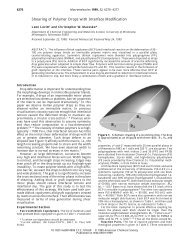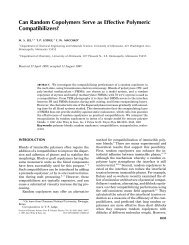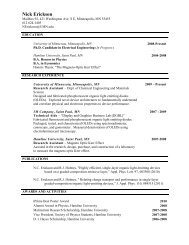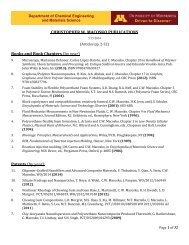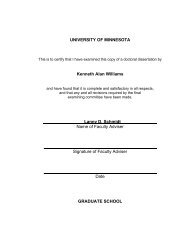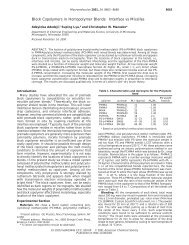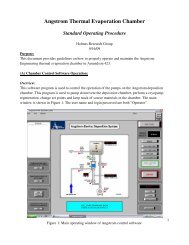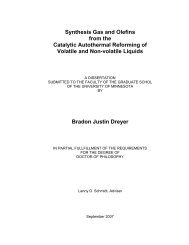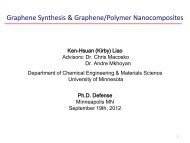Nanodispersions of carbon nanofiber for polyurethane foaming
Nanodispersions of carbon nanofiber for polyurethane foaming
Nanodispersions of carbon nanofiber for polyurethane foaming
Create successful ePaper yourself
Turn your PDF publications into a flip-book with our unique Google optimized e-Paper software.
Author's personal copyG. Harikrishnan et al. / Polymer 51 (2010) 3349e3353 3351a1000bG (Pa)Polyol-1%CNFMDI-1%CNFG (Pa)1000Polyol-3%CNFMDI-3%CNF10010010.0100ω (rad/s)100010.0100ω (rad/s)1000Fig. 2. Linear viscoelastic properties <strong>of</strong> CNF e component blends (a) 1% CNF in components (b) 3% CNF in components.3.3. Cell morphology and closed cell content <strong>of</strong> cured foamThe scanning electron micrographs in Fig. 3 show the cellmorphology <strong>of</strong> neat and CNF based foams. The cell size shows slightreduction by the addition <strong>of</strong> CNF. The corresponding cell densitiesare shown in Table 3. The potential nucleant density <strong>of</strong> filler duringheterogeneous bubble nucleation can be calculated by thefollowing equation [15].PND ¼ w r Pr compositeV P(1)where PND denotes potential nucleant density, w the weight fraction<strong>of</strong> the particle in the composite, r P is the density <strong>of</strong> the particle,r composite is the density <strong>of</strong> the polymer blend and V P is the volume <strong>of</strong>individual particle. According to above equation, the potentialnucleant density <strong>for</strong> 1% CNF in polyol (w 0.42% in foam) is1.17 10 12 /cm 3 . The observed cell density is 1.21 10 4 /cm 3 . In thecase <strong>of</strong> polystyrene foams, the potential nucleant density and theobserved cell density <strong>for</strong> 1% <strong>of</strong> CNF were 1.41 10 12 /cm 3 and2.78 10 10 /cm 3 , respectively [9]. This means that the nucleatingefficiency <strong>of</strong> CNF in reactive <strong>foaming</strong> <strong>of</strong> PU is significantly inferior tothat <strong>of</strong> non-reactive thermoplastic <strong>foaming</strong>. Fig. 3 (e) & (f) showsthe high magnification SEM micrographs <strong>of</strong> neat and nanocompositefoams. It is clear from Fig. 3(f) that the nan<strong>of</strong>ibers arelocated on the cell windows <strong>of</strong> the foam.The closed cell content <strong>of</strong> both neat and nanocomposite foamsis essentially the same (Table 3). This indicates that CNF did notinduce cell opening and hence did not cause the loss <strong>of</strong> blowingagent. This is due to the fact that CNF particles are not anti<strong>foaming</strong>in nature, so that they do not induce film drainage andrupture. Particles which are phobic to <strong>polyurethane</strong> liquid matrixwill have de-wetting effect on cell window lamellae and thusaccelerates capillary drainage from the film resulting in coalescenceand rupture [16]. It has been shown that montmorillonitebased nano clays, owing to their anti<strong>foaming</strong> property, inducedpowerful cell opening in <strong>polyurethane</strong> foams, effectivelyincreasing the k-value and decreasing the thermal insulatingefficiency <strong>of</strong> the foam [6].3.4. Thermal conductivity, compressive modulus and fire resistanceThe thermal conductivity values shown in Table 3 fall in therange <strong>of</strong> k-values <strong>for</strong> commercial foams (0.01e0.02 W/mK). It isinferred that the thermal conductivity is reduced by 5.4% with theaddition <strong>of</strong> 1% CNF in MDI (w0.5% in foam), effectively increasingthe thermal insulating capacity <strong>of</strong> foam. This is much higher thanthe reported 2.8% reduction in k-value by the addition <strong>of</strong> up to10% <strong>of</strong> organically modified montmorillonite [3]. The reduction ink-value may be due to the combined effect <strong>of</strong> nucleation andreduction in radiative heat transfer by CNF. In a foam, the thermalconductivity comprises <strong>of</strong> contributions from various mechanisms<strong>of</strong> heat transfer such as conduction, convection and radiation. Inrigid <strong>polyurethane</strong> foam system, the contribution <strong>of</strong> convectiveheat transfer <strong>of</strong> blowing gas is shown to be insignificant [17,18].The effective thermal conductivity in a gas-solid two phase foamsystem k e (W/mK) could be represented as;k e ¼ k s þ k g þ 16sT3(2)33where, k s (W/mK) is the thermal conductivity <strong>of</strong> the solid, k g is thevapor phase thermal conductivity <strong>of</strong> gas phase, s is the StephaneBoltzmann’sconstant, T, the temperature (K), 3 (m 1 ) is theextinction coefficient. The third term <strong>of</strong> above equation denotes theradiative contribution to thermal conductivity (k r ). The rate <strong>of</strong>radiative heat transfer contributes to about 25% <strong>of</strong> the total rate <strong>of</strong>heat transfer in the foam [19]. Carbonaceous materials such as<strong>carbon</strong> black have been shown to decrease the radiative heattransfer in PU foams by increasing the opacity to infrared radiation<strong>of</strong> the cell windows and struts and there<strong>for</strong>e decreasing the passage<strong>of</strong> infrared radiation through the foam [20].From Table 3, it is seen that the normalized (<strong>for</strong> density)compressive modulus <strong>of</strong> the nanocomposite foams increases. Sahaet al. also reported similar trend [11]. Regarding fire resistance <strong>of</strong>the foam, it is noted that the weight retention after the removal <strong>of</strong>the flame increases by 13% by the addition <strong>of</strong> 1% CNF in MDI (correspondingto 0.42% in foam) showing an enhanced fire resistance<strong>of</strong> the nanocomposite foam.Table 2Kinetic pr<strong>of</strong>ile <strong>of</strong> <strong>foaming</strong>.CNF (%wt) Gel time 2 (s) Rise time 3 (s)0 49 701% (Polyol) 47 711% (MDI) 46 684. Conclusions<strong>Nanodispersions</strong> <strong>of</strong> <strong>carbon</strong> nan<strong>of</strong>iber in <strong>polyurethane</strong> componentshave been prepared. Rheological estimations show thata filler loading as low as 3% in components is sufficient <strong>for</strong> makinga highly cross-linked network. Reactive <strong>foaming</strong> <strong>of</strong> these nanodispersionswas carried out to make <strong>polyurethane</strong> nanocomposite



